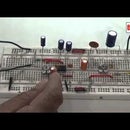Introduction: Cellphone-Based Remote Controller for Water Pump
Inconvenience in switching on a water pump installed in a remote farm is a common problem faced by many. A lot of circuits have been developed to solve this problem. Most of them are expensive and microcontroller-based. Here we present a cellphone-based remote controller for water pump. By calling the cellphone attached to the controller, the water pump can be directly activated.
Step 1: Circuit and Working
Fig. 1 shows the block diagram of cellphone-based remote controller for water pump. Fig. 2 shows the circuit. The circuit is built around DTMF decoder IC MT8870 (IC1), timer NE555 (IC2) wired as monostable multivibrator and a few discrete components. The main component of the circuit is IC MT8870. This DTMF decoder has band-split filter and digital decoder functions. It offers the advantages of small size, low power consumption and high performance.
Step 2: Test Points and Part List
Once monostable timer IC2 is triggered, its output goes high for the preset time period. The time period depends on the values of resistor R7 and capacitor C4. It can be adjusted between 8 and 50 minutes using pot-meter VR1. The high output at pin 3 of IC2 energises relay RL1 to switch on the water pump.
The triggering pulse for IC2 is generated by DTMF decoder IC1 and the arrangement of diodes D1 through D5. Std pin of IC1 provides a high pulse when a valid tone-pair is received. Transistor T1 conducts only when outputs Q0 through Q2 and Std are high simultaneously. This can be achieved by sending digit ‘7’ through DTMF.
The water pump controller is connected to a dedicated cellphone through connector J1 with auto-answering mode enabled. The DTMF signal sent from the user end is decoded by the DTMF decoder and the corresponding binary-coded decimal (BCD) value appears on outputs Q0 through Q3. In this circuit only three of them are used.
Working of the circuit is simple. To switch ‘on’ the water pump, call the cellphone connected to the controller circuit and press ‘7’ once the ring stops. LED1 will glow to indicate that the water pump is switched on. The water pump turns off automatically after the preset time. LED1 turns off simultaneously.
Step 3: Construction and Testing
An actual-size, single-side PCB for cell-phone-based remote controller is shown in Fig. 3 and its component layout in Fig. 4. Suitable connector is provided on the PCB to connect the cellphone. Assemble the circuit on a PCB to minimise time and assembly errors. Carefully assemble the components and double-check for any overlooked error. Use suitable IC socket for MT887 and NE555 ICs.
Use relay RL1 with contact current rating capable of carrying the water pump’s current. To test the circuit for proper functioning, press switch S1 and verify 5V at TP1 with respect to TP0. Connect the cellphone to the controller using connector J1. Call this cellphone and press ‘7’ once the ring stops. At the same time, verify high-to-low triggering pulse at TP2. TP3 now should be high for the preset time period.




